BTR-40
| BTR-40 | |
|---|---|
|
Ex-Egyptian or ex-Syrian Israeli-modified BTR-40 at the Yad la-Shiryon Museum, Israel, 2005. | |
| Type |
Wheeled Armoured Personnel Carrier Reconnaissance Vehicle |
| Place of origin | Soviet Union |
| Service history | |
| In service | 1950 - 1980s |
| Used by | See Operators |
| Production history | |
| Designer | V. A. Dedkov |
| Designed | 1947 - 1950 |
| Manufacturer |
Gorkovsky Avtomobilny Zavod unknown Chinese manufacturer |
| Produced | 1950 - 1960 (BTR-40ZhD produced until 1969) |
| Number built | 8,500 [1] |
| Variants | See Variants |
| Specifications | |
| Weight | 5.3 tonnes |
| Length | 5 m[2] |
| Width | 1.9 m[2] |
| Height | 2.2 m (1.83 m without armament) |
| Crew |
2 + 8 passengers (BTR-40 and BTR-40V)[2] 2 + 6 passengers (BTR-40B) |
|
| |
| Armor | 6-8 mm |
Main armament | 7.62 SGMB medium machine gun (1,250 rounds (total)) (optional) |
Secondary armament | 2×7.62 SGMB medium machine gun (1,250 rounds (total)) (optional) |
| Engine |
6-cylinder GAZ-40[2] 80 hp (60 kW) at 3400 rpm[2] |
| Power/weight | 15.1 hp/tonne (11.3 kW/tonne) |
| Suspension | 4x4 wheel, leaf spring |
| Ground clearance | 400 mm[2] |
| Fuel capacity | 122 l[2] |
Operational range |
430 km (road)[2] 385 km (cross country)[2] |
| Speed | 80 km/h[2] |
The BTR-40 (БТР, from Бронетранспортер, or Bronetransporter, literally "armoured transporter".†) is a Soviet non-amphibious, wheeled armoured personnel carrier and reconnaissance vehicle.[3] It is often referred to as the Sorokovka in Soviet service.[4] It is also the first mass-produced Soviet APC. It was eventually replaced in the APC role by the BTR-152 and in the scout car role by the BRDM-1.
Development History
The BTR-40's development began in early 1947 at the design bureau of the Gorkovsky Avtomobilny Zavod (Gorkovsky Automobile Factory) under the leadership of V. A. Dedkov. The concept was a successor to the BA-64B armoured car which went out of production in 1946. The design team also included L. W. Kostikin and P.I. Muziukin. Two prototypes designated BTR-141 were completed in 1947. The first was armed with two coaxial 14.5 mm KPVT heavy machine guns on a rotatable mount which was protected by armour plate at the front and sides. The second had no fixed armament. Neither one was accepted for service. In 1950 two new prototypes were produced. Those had a different shape of armour including an upright rear armour. Again one prototype had no fixed armament and the second was armed with two coaxial 14.5 mm KPVT heavy machine guns. These were accepted into service as BTR-40 and BTR-40A respectively.[5]
The vehicle's drawbacks, such as its poor cross-country performance and problems with crossing water obstacles, compelled the design team to produce, in late 1954, what was planned to be an amphibious variant of the BTR-40. It received the designation BTR-40P (with the 'P' standing for pławajuszczij - "swimming"). During the design process, the vehicle moved away from the APC concept and became an amphibious armoured scout car. It received a new designation - BRDM.
Description
Overview
The BTR-40's design was based on the GAZ-63 four wheel drive truck which went into production in 1946. The design featured a self-bearing body which was a new feature in Soviet vehicles. The hull has two side doors for the commander and driver and a back door. The vehicle can transport up to eight fully equipped soldiers or 1 tonne of cargo.[5]
Though it should be noted that the vehicle does slightly resemble the White M3 Scout Car that the Soviet Union received via the United States government's Lend Lease Program during the Second World War.
Protection
The BTR-40's armour is from 6 mm to 8 mm thick which gives it protection from small arms fire and the shell splinters of its time, but does not protect it against modern artillery fragments and .50-calibre machine gun fire. The BTR-40-series tyres are not protected by armour. They are particularly vulnerable to puncture from fire of all kinds. The vehicle has no roof and is normally covered with a tarpaulin to protect the crew, transported cargo or troops from rain and snow. However this makes it unable to mount any of the SGMB machine guns.[5]
Armament
The APC variant has no permanent armament but it has pintle mounts for three 7.62 mm SGMB medium machine guns, one at the front of the troop compartment and the other two at the sides. The vehicle also has two firing ports on both sides of the hull which allow up to four soldiers to use their weapons while being protected by the APC's armour.[5]
Maneuverability
Like the GAZ-63 truck on which it is based BTR-40 has a four wheel drive. The chassis however is shorter compared to the GAZ-63. The only other thing that distinguished the chassis of the BTR-40 from that of the GAZ-63 were additional shock absorbers. BTR-40 also has a more powerful engine. The turning angle was 7.5 m.[5]
Equipment
The vehicle has the 10RT-12 receiving and airing radio which has a range of 20–25 km and a winch at the front, with a maximum capacity of 4.5 tonnes and 70 m of cable. It has no protection against nuclear, biological and chemical (NBC) weapons. It also has no night vision equipment.[5]
Service history
Soviet Union
The BTR-40 was produced at the Gorkovsky Avtomobilny Zavod (Gorkovsky Automobile Factory) from 1950 to 1960. It was first shown publicly at the military parade in Moscow in 1950.[5] It was issued to the Red Army in 1950 and was used in the APC, reconnaissance and command post roles. After several years of service, it became apparent that it did not fit the modern battlefield. It was replaced by the BTR-152.

Foreign service
The BTR-40 began to enter service with two other Warsaw Pact members in late 1949, namely East Germany and Poland, where it was used as a standard APC until more advanced vehicles like the BTR-152 were available. The last BTR-40s were withdrawn from Warsaw Pact countries in the early 1970s. The vehicle was also sold to many Arab and African nations in the late 1950s and early 1960s.
The People's Republic of China (PRC), had developed a copy of the BTR-40 called the Type 55. It is unknown how many of these vehicles entered service with the PLA. The vehicle was also exported to North Korea, probably as part of a military assistance programme during the Korean War, where it saw combat for the first time. It was later used by the North Vietnamese Army during the Vietnam War.[6]
BTR-40 also saw combat service during the North Yemen Civil War during which at least one was captured from the Egyptians by the royalist guerrillas.
Variants
Former USSR
.jpg)
- BTR-141 (1947) - The original prototype with a faceted rear hull had two variants. The first was armed with twin ZPTU-2 14.5 mm KPV heavy machine guns placed in a rotary platform with armour protection at the front and sides. The second version had no permanent armament but later became the BTR-40.[5]
- BTR-40 (1950) - Original production model.
- BTR-40A (1950) - BTR-40 converted into a SPAAG armed with twin ZPTU-2 14.5 mm twin anti-aircraft gun (2400 rounds) in a turret, later also used in the BTR-152A, manually operated by a single soldier. The turret is placed inside the troop compartment. It can make a full turn and its guns can elevate between -5 and +80 degrees.[5] This variant does not have the firing ports in the hull sides.
- BTR-40V (1956) - BTR-40 fitted with an external tyre pressure regulation system.[5]
- BTR-40B (1957) - BTR-40V with an armoured roof with four hatches. The vehicle has a filtering/ventilation system, NBC protection system and central tyre pressure regulation system. It also has a pintle mount for a 12.7 mm or 14.5 mm heavy machine gun, although the standard version of the BTR-40B had no fixed armament.[5] It was designed for use as a reconnaissance vehicle. Crew was reduced from 2 + 8 passengers to 2 + 6.
- BTR-40Kh - NBC reconnaissance vehicle.
- BTR-40ZhD (1959) - BTR-40 equipped with small rail wheels mounted to the front and rear of the vehicle on special supports.[5]
- BRDM-1 - Armoured car which uses a number of BTR-40 components. Originally planned to be an amphibious variant of the BTR-40 and therefore it received the designation BTR-40P.
- BTR-40 (1950) - Original production model.
The People's Republic of China
- Type 55 - Chinese copy of the BTR-40.[7][8] Possibly also a designation for the Soviet-supplied BTR-40s.
Cuba
- BTR-40A-AA - A Cuban air defence vehicle. It uses the chassis and the armoured front of the BTR-40 but the troop compartment has been removed in favour of a square sided platform mount with drop down sides and rear on which twin ZPTU-2 14.5 mm KPV heavy machine guns are placed.
- BTR-40A-PB - A Cuban BTR-40 armed with an anti-tank guided missile (ATGM) launcher. While travelling, the launcher is hidden in the superstructure so that from a distance, the vehicle cannot be easily distinguished from a normal BTR-40. The superstructure also provides the launcher with armour protection. When in position, the roof of the superstructure is opened sideways and the launcher is elevated.
- Jababli - Is a Cuban BTR-40 fitted with a 3M11 Falanga (AT-2 Swatter) ATGM launcher on a launch platform in a cut-down superstructure. Only a limited number were built. NATO gave it the designation M1975/4.
Former East Germany
- SPW-40 - The East German designation for a BTR-40.
- SPW-40A - The East German designation for a BTR-40A.
- SPW-40Ch - The East German designation for a BTR-40Kh.
- SPW-40 converted into a tank destroyer armed with an elevatable ATGM launcher capable of firing 9M14 Malyutka ATGMs with an armoured roof over it in a cut down troop compartment. This variant does not have the firing ports in the hull sides.[5]
Indonesia
- BTR-40 converted into an armoured car armed with a medium machine gun in a cube-shaped turret on top of the superstructure inside the troop compartment. It also has four smoke grenade launchers on both sides of the hull.
- BTR-40 converted into an armoured car armed with a 40 mm gun in an angular turret on top of the superstructure inside the troop compartment, it also has four smoke grenade dischargers on both sides of the hull. It has a searchlight on the left hand side of the hull. It is intended to be used for fire support.
Israel
- BTR-40 fitted with pintle mounts for the US M1919A4 .30 cal medium machine guns, one in the forward part of the troop compartment and two on either side as well a large number of equipment holders on the hull.[2]
Operators
-
 Angola — 32 were ordered in 1975 from the Soviet Union and delivered in 1975 (the vehicles were previously in Soviet service).[7]
Angola — 32 were ordered in 1975 from the Soviet Union and delivered in 1975 (the vehicles were previously in Soviet service).[7] -
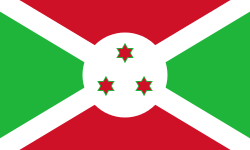 Burundi — 16 were ordered in 1980 from the Soviet Union and delivered in 1980 (the vehicles were second-hand).[7]
Burundi — 16 were ordered in 1980 from the Soviet Union and delivered in 1980 (the vehicles were second-hand).[7] -
 Cambodia -
Cambodia - -
 Cuba — 100 ordered in 1960 from the Soviet Union and delivered in 1961 and 1962 (the vehicles were previously in Soviet service).[7]
Cuba — 100 ordered in 1960 from the Soviet Union and delivered in 1961 and 1962 (the vehicles were previously in Soviet service).[7] -
 Egypt — 350 were ordered from the Soviet Union in 1955 and delivered between 1955 and 1959. 30 SPW-40Chs were ordered in 1991 from Germany and delivered later that year (aid during the First Gulf War).[7] 200 in service at present.[9]
Egypt — 350 were ordered from the Soviet Union in 1955 and delivered between 1955 and 1959. 30 SPW-40Chs were ordered in 1991 from Germany and delivered later that year (aid during the First Gulf War).[7] 200 in service at present.[9] -
 Ethiopia — 100 ordered in 1977 from the Soviet Union and delivered in 1977 and 1978 (the vehicles were previously in Soviet service).[7]
Ethiopia — 100 ordered in 1977 from the Soviet Union and delivered in 1977 and 1978 (the vehicles were previously in Soviet service).[7] -
 Guinea — 16 were ordered in 1970 from the Soviet Union and delivered the same year (the vehicles were second-hand).[7]
Guinea — 16 were ordered in 1970 from the Soviet Union and delivered the same year (the vehicles were second-hand).[7] -
 Guinea-Bissau — 15 were ordered in 1978 from the Soviet Union and delivered the same year (the vehicles were second-hand).[7]
Guinea-Bissau — 15 were ordered in 1978 from the Soviet Union and delivered the same year (the vehicles were second-hand).[7] -
 Indonesia — 85[10]
Indonesia — 85[10] -
 North Korea — 100 BTR-40s were ordered in 1949 from the Soviet Union and delivered between 1950 and 1957. 250 were ordered in 1965 from the Soviet Union and delivered between 1965 and 1971 (the vehicles were previously in Soviet service).[7] North Korea also bought a number of Type 55s from the PRC.
North Korea — 100 BTR-40s were ordered in 1949 from the Soviet Union and delivered between 1950 and 1957. 250 were ordered in 1965 from the Soviet Union and delivered between 1965 and 1971 (the vehicles were previously in Soviet service).[7] North Korea also bought a number of Type 55s from the PRC. -
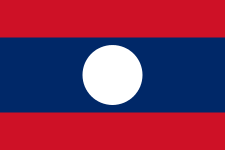 Laos — 10 were ordered in 1961 from the Soviet Union and delivered in 1962 (the vehicles were previously in Soviet service).[7]
Laos — 10 were ordered in 1961 from the Soviet Union and delivered in 1962 (the vehicles were previously in Soviet service).[7] -
 Mali — 15 were ordered in 1960 from the Soviet Union and delivered in 1961 (the vehicles were previously in Soviet service).[7]
Mali — 15 were ordered in 1960 from the Soviet Union and delivered in 1961 (the vehicles were previously in Soviet service).[7] -
 Mongolia — 200 ordered in 1961 from the Soviet Union and delivered between 1961 and 1964.[7]
Mongolia — 200 ordered in 1961 from the Soviet Union and delivered between 1961 and 1964.[7] -
 Nicaragua — 20 ordered in 1980 from the Soviet Union and delivered in 1981 and 1982 (the vehicles were previously in Soviet service).[7]
Nicaragua — 20 ordered in 1980 from the Soviet Union and delivered in 1981 and 1982 (the vehicles were previously in Soviet service).[7] -
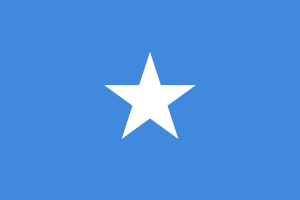 Somalia — 60 were ordered in 1964 from the Soviet Union and delivered the following year (the vehicles were previously in Soviet service).[7]
Somalia — 60 were ordered in 1964 from the Soviet Union and delivered the following year (the vehicles were previously in Soviet service).[7] -
 Sudan
Sudan -
 Syria — 100 ordered in 1955 from the Soviet Union and delivered that year.[7] Around 1,500 BTR-40s, BTR-50s, BTR-60PBs, BTR-152s and OT-64s in service in 1990, 1995 and 2000 and around 1,600 in 2001, 2003 and 2005.[11]
Syria — 100 ordered in 1955 from the Soviet Union and delivered that year.[7] Around 1,500 BTR-40s, BTR-50s, BTR-60PBs, BTR-152s and OT-64s in service in 1990, 1995 and 2000 and around 1,600 in 2001, 2003 and 2005.[11] -
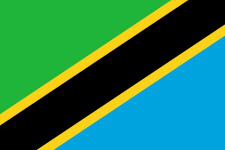 Tanzania
Tanzania -
 Uganda — 10 ordered in 1968 from the Soviet Union and delivered between 1968 and 1970 (the vehicles were previously in Soviet service). 50 ordered in 1973 from the Soviet Union and delivered between 1973 and 1975 (the vehicles were previously in Soviet service).[7]
Uganda — 10 ordered in 1968 from the Soviet Union and delivered between 1968 and 1970 (the vehicles were previously in Soviet service). 50 ordered in 1973 from the Soviet Union and delivered between 1973 and 1975 (the vehicles were previously in Soviet service).[7] -
 Vietnam — BTR-40 and BTR-40A[6]
Vietnam — BTR-40 and BTR-40A[6] -
 Yemen — 670
Yemen — 670
Former Operators
-
.svg.png) Afghanistan — 100 were ordered in 1958 from the Soviet Union and delivered in 1959 and 1960.[7]
Afghanistan — 100 were ordered in 1958 from the Soviet Union and delivered in 1959 and 1960.[7] -
.svg.png) People's Socialist Republic of Albania — 200
People's Socialist Republic of Albania — 200 -
 Algeria — 100 were ordered in 1965 from the Soviet Union and delivered in 1966 and 1967 (the vehicles were previously in Soviet service).[7]
Algeria — 100 were ordered in 1965 from the Soviet Union and delivered in 1966 and 1967 (the vehicles were previously in Soviet service).[7] -
 People's Republic of Bulgaria — 150 were ordered in 1954 from The Soviet Union and delivered between 1955 and 1957.[7] Withdrawn from service in the 1980s.
People's Republic of Bulgaria — 150 were ordered in 1954 from The Soviet Union and delivered between 1955 and 1957.[7] Withdrawn from service in the 1980s. -
 People's Republic of China — 100 BTR-40s were ordered in 1956 from the Soviet Union and delivered between 1957 and 1960. It was later copied and produced in the PRC under the designation Type 55.[7] In service in 1985 and 1990. None in service in 1995.[8]
People's Republic of China — 100 BTR-40s were ordered in 1956 from the Soviet Union and delivered between 1957 and 1960. It was later copied and produced in the PRC under the designation Type 55.[7] In service in 1985 and 1990. None in service in 1995.[8] -
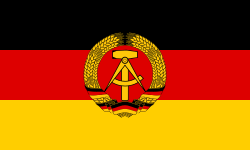 East Germany — 300 ordered in 1956 from the Soviet Union and delivered in 1956 and 1957.[7] Passed on to the successor state.
East Germany — 300 ordered in 1956 from the Soviet Union and delivered in 1956 and 1957.[7] Passed on to the successor state. -
 Germany — Inherited from East Germany's Army. All scrapped or sold to other states.
Germany — Inherited from East Germany's Army. All scrapped or sold to other states. -
 People's Republic of Hungary — 200 were ordered in 1951 from The Soviet Union and delivered in 1953.[7]
People's Republic of Hungary — 200 were ordered in 1951 from The Soviet Union and delivered in 1953.[7] -
 Palestinian Liberation Organization - Passed on to the al-Murabitun militia.
Palestinian Liberation Organization - Passed on to the al-Murabitun militia. -
 Iran — 100
Iran — 100 -
 Israel — 50
Israel — 50 -
 Poland — 400 ordered in 1951 from the Soviet Union and delivered between 1952 and 1955.[7] Replaced by the BTR-152.
Poland — 400 ordered in 1951 from the Soviet Union and delivered between 1952 and 1955.[7] Replaced by the BTR-152. -
.svg.png) Socialist Republic of Romania — Withdrawn from service after 1990.
Socialist Republic of Romania — Withdrawn from service after 1990. -
 Soviet Union — Replaced by the BTR-152.
Soviet Union — Replaced by the BTR-152. -
 North Vietnam — 100 ordered in 1963 from the Soviet Union and delivered between 1963 and 1966 (the vehicles were previously in Soviet service).[7] North Vietnam operated both BTR-40s and BTR-40As.[6] Passed on to the successor state.
North Vietnam — 100 ordered in 1963 from the Soviet Union and delivered between 1963 and 1966 (the vehicles were previously in Soviet service).[7] North Vietnam operated both BTR-40s and BTR-40As.[6] Passed on to the successor state. -
 Mutawakkilite Kingdom of Yemen — At least 1 captured from the Egyptians by the royalist guerrillas.
Mutawakkilite Kingdom of Yemen — At least 1 captured from the Egyptians by the royalist guerrillas. -
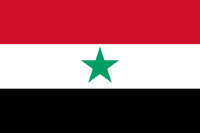 North Yemen — 70 ordered in 1960 from the Soviet Union and delivered in 1961 (the vehicles were previously in Soviet service).[7]
North Yemen — 70 ordered in 1960 from the Soviet Union and delivered in 1961 (the vehicles were previously in Soviet service).[7] -
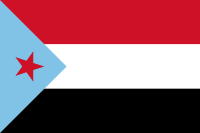 People's Democratic Republic of Yemen — 60 ordered in 1973 from the Soviet Union and delivered in 1973 (the vehicles were previously in Soviet service).[7]
People's Democratic Republic of Yemen — 60 ordered in 1973 from the Soviet Union and delivered in 1973 (the vehicles were previously in Soviet service).[7] -
 Yugoslavia — 40 ordered in 1962 from the Soviet Union and delivered in 1962.[12] Replaced in the 1980s.
Yugoslavia — 40 ordered in 1962 from the Soviet Union and delivered in 1962.[12] Replaced in the 1980s.
References
- ↑ Jane's Armour and Artillery 2005-2006.
- ↑ 2.0 2.1 2.2 2.3 2.4 2.5 2.6 2.7 2.8 2.9 2.10 "BTR-40 ZSRR Strona 2 z 2" (in Polish). Pancerni.net.
- ↑ Foss, Christopher. Jane's Tank Recognition Guide. (New York: HarperCollins, 2006), p.288.
- ↑ ibid.
- ↑ 5.0 5.1 5.2 5.3 5.4 5.5 5.6 5.7 5.8 5.9 5.10 5.11 5.12 "BTR-40 ZSRR Strona 1 z 2" (in Polish). Pancerni.net.
- ↑ 6.0 6.1 6.2 "North Vietnamese Armor"
- ↑ 7.0 7.1 7.2 7.3 7.4 7.5 7.6 7.7 7.8 7.9 7.10 7.11 7.12 7.13 7.14 7.15 7.16 7.17 7.18 7.19 7.20 7.21 7.22 7.23 7.24 7.25 "Trade Registers". Retrieved 24 December 2014.
- ↑ 8.0 8.1 John Pike. "People's Liberation Army". Retrieved 24 December 2014.
- ↑ Egyptian army armyrecognition.com
- ↑ "BTR-40 : Panser Yang Nyaris Jadi Besi Tua". IndoMiliter. Retrieved 24 December 2014.
- ↑ John Pike. "Syria - Army Equipment". Retrieved 24 December 2014.
- ↑ Trade Register 1950 to 2007
External links
| Wikimedia Commons has media related to BTR-40. |
- BTR-40 foto and forum
- globalsecurity.org
- (Russian) Description and photo gallery at armoured.vif2.ru
- (Russian) Description and photo gallery at legion.wplus.net
- Website and Pictures
| ||||||||||||||
| ||||||||||||||||||||||||||||||||||||||||||||||||||||||||||||||||||||||||||
